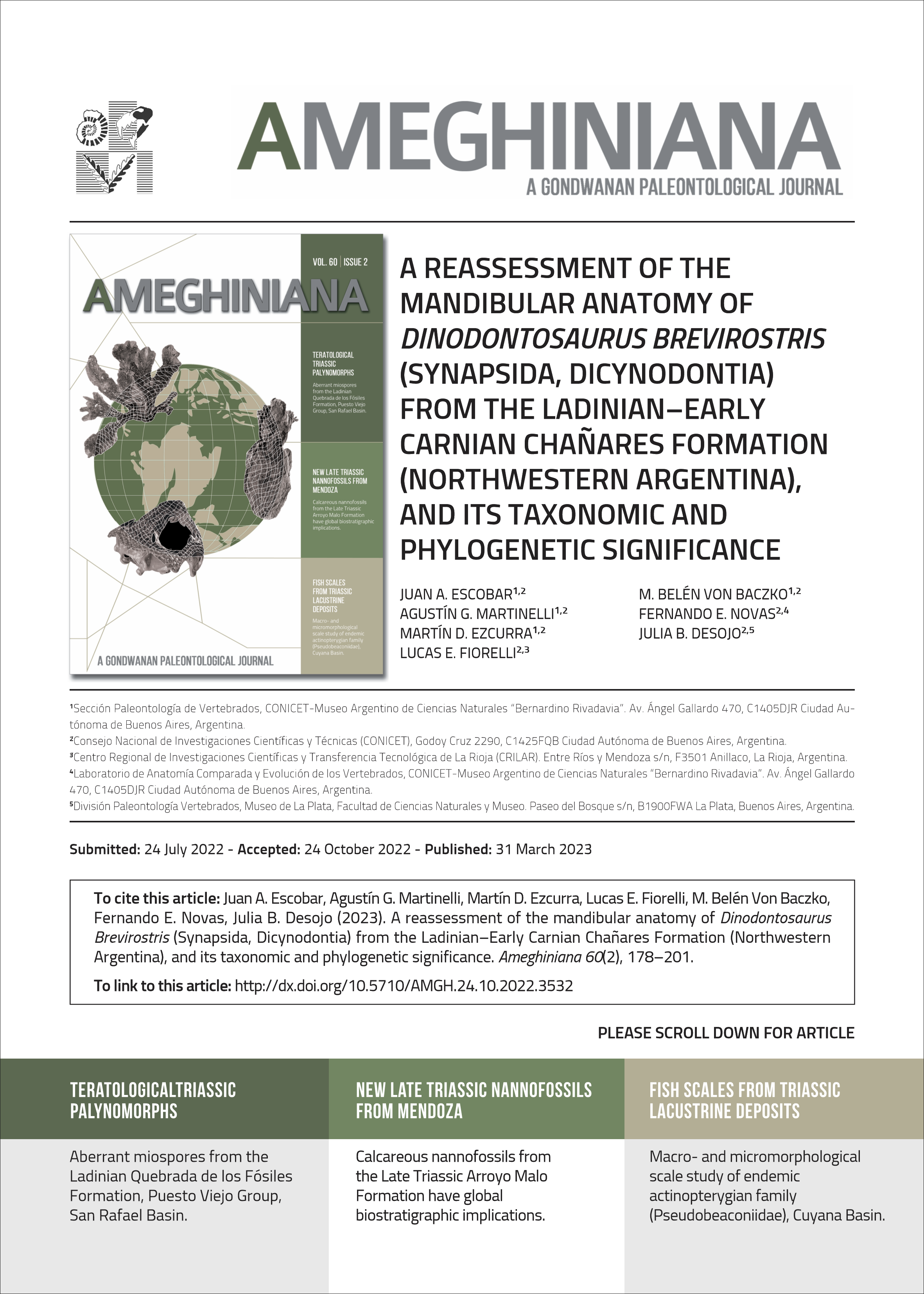A REASSESSMENT OF THE MANDIBULAR ANATOMY OF DINODONTOSAURUS BREVIROSTRIS (SYNAPSIDA, DICYNODONTIA) FROM THE LADINIAN–EARLY CARNIAN CHAÑARES FORMATION (NORTHWESTERN ARGENTINA), AND ITS TAXONOMIC AND PHYLOGENETIC SIGNIFICANCE
DOI:
https://doi.org/10.5710/AMGH.24.10.2022.3532Keywords:
Kannemeyeriiformes, Dinodontosaurus brevirostris, lower jaw, Triassic, Ischigualasto Villa-Unión BasinAbstract
Two lineages of Kannemeyeriiformes (Synapsida, Dicynodontia) are currently known in the Ladinian–Carnian Chañares Formation (Ischigualasto-Villa Unión Basin, Argentina): stahleckeriine stahleckeriids, based upon postcrania, and a single non-stahleckeriine species, Dinodontosaurus brevirostris, known mostly by cranial material. Available data on the mandible of Dinodontosaurus brevirostris is mainly based on specimen PULR-V 03, holotype of D. “platygnathus”. Here we present a comprehensive and comparative osteological study of the lower jaw of D. brevirostris, based on PULR-V 03 and the new specimens CRILAR-Pv 94 and PULR-V 144, and revise its phylogenetic relationships with the inclusion of the mandibular data. Our results resemble previous analyses, with a monophyletic Dinodontosaurus as the sister group of the Angonisaurus + Stahleckeriidae clade. Dinodontosaurus brevirostris is reinterpreted has having an angular contribution to the mandibular symphysis, rounded and hypertrophied reflected lamina of the angular, wide angular gap, and well-developed and anteriorly curving retroarticular process. Previous hypotheses of stahleckeriine affinities are rejected based on the markedly convex symphysial chin, wide angular gap, median symphysial ridge, and moderately sloping articular surface, but the shape and size of the reflected lamina is consistent with the position of Dinodontosaurus as a close relative of Stahleckeriidae. Traits potentially relevant for the distinction from D. tener and other kannemeyeriiforms (tall medial ridge on the dentary table, anterolateral trough in the angular, angular contribution to symphysis, extreme narrowness of the symphysial ridge, wide and deep median dentary groove) need further research in other dicynodont groups in order to robustly interpret their evolutionary history.

Downloads
Additional Files
Published
Issue
Section
License
Authors publishing in Ameghiniana have the option of making their article freely available online. Authors opting for the Open Access must pay a fee of $300 (US dollars) to cover article-processing costs and to ensure the article is made open access. Please contact the Production Team after the acceptance of your manuscript if you are interested in making your article Open Access. This option implies by default a license Creative Commons Attribution Non-Commercial-NoDerivs License (CC BY NC ND). If your funding institution requires a different licensing option please communicate this to the Production Team after the acceptance of your manusctipt.










